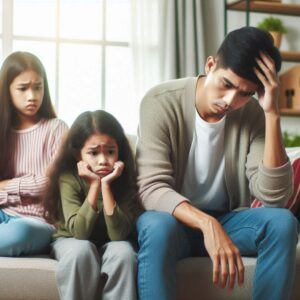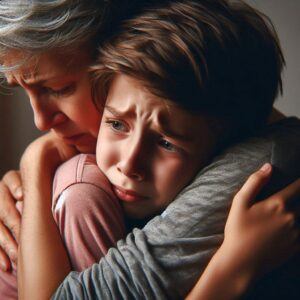 Imagine a ripple in a pond, starting small but spreading wide. Now picture that ripple hitting a family; that’s the effect Post-Traumatic Stress Disorder (PTSD) can have. It’s not just an individual challenge; it’s a family concern. PTSD stems from exposure to traumatic events such as military combat, natural disasters, serious accidents, or personal assaults.
Imagine a ripple in a pond, starting small but spreading wide. Now picture that ripple hitting a family; that’s the effect Post-Traumatic Stress Disorder (PTSD) can have. It’s not just an individual challenge; it’s a family concern. PTSD stems from exposure to traumatic events such as military combat, natural disasters, serious accidents, or personal assaults.
When a family member lives with PTSD, their symptoms—like nightmares, irritability, and hypervigilance—don’t exist in isolation. They impact relationships, parenting, and the overall atmosphere of the home. A parent who is easily startled or angered can create a tense environment. This, in turn, affects children and partners, often leading to miscommunication and strain.
As roles and relationships within the family shift to accommodate the changing needs of the person with PTSD, everyone finds themselves adapting. A partner might take on more responsibilities, children might become caretakers, and families can sometimes struggle to maintain a sense of normalcy.
This article sets the stage for understanding the profound influence that PTSD can have on families. By acknowledging these challenges, families can take the first steps toward managing PTSD’s impact more effectively and with compassion.
Recognizing the Signs: How Families Can Identify PTSD

Family members must detect the presence of PTSD as early as possible. Doing so can lead to timely support and treatment, which may improve outcomes for everyone involved. However, understanding what to look for is not always straightforward. PTSD can manifest in various behaviors and symptoms that may be subtle or misunderstood as other issues.
For adults living with PTSD, symptoms often involve reliving the traumatic event through flashbacks or nightmares, exhibiting avoidance behaviors like steering clear of places that remind them of the trauma and showing changes in mood and thinking. You might notice a loved one being easily startled or on edge, displaying aggressive or irritable behaviors, or withdrawing from social interactions altogether.
Children can also display signs of PTSD, although they can be quite different from those seen in adults. Younger children may regress to behaviors typical of an earlier developmental stage, such as bed-wetting or being unusually clingy. Meanwhile, older children and teenagers might express their distress through disruptive, disrespectful, or destructive behaviors. They might also reenact the traumatic event during play or have intense, irrational fears unrelated to the trauma.
Awareness is the first step towards addressing the challenge. Being informed about PTSD can significantly improve the likelihood of family members getting the right support. Educational materials, mental health professionals, and PTSD support groups can offer valuable insight into recognizing the signs.
With awareness, families can move toward providing the right kind of support and intervention, discussed in the next section, to help their loved one heal from PTSD and prevent further emotional strain on the family unit.
Emotional Toll: The Psychological Strain on Spouses and Children

It’s often said that when one family member suffers from PTSD, the entire family struggles. The emotional toll on those closest to the individual can be profound and far-reaching. My focus here is to shed light on these less visible but significant effects.
Spouses often become the primary caretakers, both emotionally and sometimes physically, for a loved friend or partner with PTSD. This role, while filled with love and commitment, can lead to feelings of exhaustion, loneliness, and sometimes resentment. If I had to pinpoint a recurring theme in these households, it would be the overshadowing presence of an emotional burden that is difficult to manage.
Children, with their intuitive and sensitive nature, pick up on the tensions and disruptions a PTSD-affected parent brings into the home. Whether in the form of nightmares, outbursts, or withdrawal, the ripple effects are palpable in their daily lives. These children may face challenges in school, struggle with forming friendships, or develop fears and anxieties of their own.
A critical point to emphasize is the importance of communication. The strain PTSD places on family interactions can lead to misunderstandings and alienation. It’s like trying to navigate a maze in the dark. Clear, compassionate, and honest conversations can be the proverbial flashlight that helps guide everyone through the maze.
A family’s emotional bond, the very glue that holds it together, can be tested during these trying times. It’s imperative to actively strengthen these bonds, to prevent the isolation and emotional drift that PTSD can induce. While this sounds straightforward on paper, I understand that real-life execution is far more complex.
Navigating Family Support: Helping a Loved One with PTSD
Supporting a family member with PTSD is a marathon, not a sprint. Understanding the balance between helping your loved one and maintaining your well-being can be challenging. This challenge necessitates clear communication and defined boundaries. Everyone’s goal is to assist without inadvertently contributing to a cycle of dependency or enabling behaviors that may hinder recovery.
Clear communication is the foundation of supporting someone with PTSD. It’s crucial to foster an environment where open and honest discussions about feelings, symptoms, and experiences are normalized. This doesn’t mean forcing conversations, but rather creating a space where your loved one can share when ready. Active listening plays a pivotal role here, as does patience.
In this endeavor, boundaries are essential. By setting limits on what you can and cannot do, you respect both your own limits and those of your family member with PTSD. It’s not selfish to prioritize self-care; it’s vital. When you’re well, you’re more able to provide effective support. Remember: Helping doesn’t mean fixing everything.
It’s common to feel unequipped to manage the complexities of PTSD alone, and there’s no shame in seeking professional help. Therapists and counselors can guide your family through the process, offering targeted strategies for supporting your loved one. Additionally, support groups for families affected by PTSD can provide a community of understanding and shared experiences.
While the journey can be taxing, remember it’s a shared one. Your support can make a world of difference, but it’s important not to carry the burden alone. Lean on professional resources, support systems, and each other to navigate the path ahead.
Calm Your Mind Instantly: Get Your Free Zen12 Meditation Audio
Building Resilience: Strengthening Families in the Aftermath of PTSD

In my experience, when a family member suffers from PTSD, the entire family faces a heavy burden. It’s not just the affected individual, but it’s everyone who cares for them. But there is room for hope and growth after such a turbulent period. Let’s talk about post-traumatic growth as a family. It’s a concept where, following hardship, families can emerge stronger and more connected than before.
One key factor in fostering resilience is open communication. By talking about experiences and emotions, families can begin to rebuild trust and establish a sense of safety. This doesn’t happen overnight. It takes time and often requires the guidance of a professional, but the results are worth the commitment. Seeing a family come together and support each other through PTSD is a powerful testament to human compassion and strength.
Developing coping skills is crucial. Each family will have its own set of strategies that work best for them. It might be regular family meetings, individual therapy sessions, or shared activities. And when progress is made, no matter how small, it’s important to recognize and celebrate it. These moments of acknowledgment foster positivity and motivate further growth.
Maintaining a hopeful outlook is not about ignoring the pain and challenges that come with PTSD. It’s about believing in the possibility of a future where these difficulties are managed and don’t define the family’s life. It’s a commitment to working towards that vision together.
Lastly, I know that maintaining long-term resilience requires continued effort and adaptation. Families will face other stressors and challenges, but the skills and bonds formed during the recovery journey can help them withstand future tests. Resilience is not a static achievement; it’s an ongoing process. As families continue to navigate their lives, the experience of overcoming PTSD can serve as a testament to their ability to handle adversity with grace and unity.
References:
- National Center for PTSD – How PTSD Affects Family Members. https://www.va.gov/
- American Psychological Association – PTSD. https://www.apa.org/
- Mental Health America – PTSD and its Impact on the Family. https://www.mhanational.org/
- National Alliance on Mental Illness (NAMI) – PTSD: How to Support a Loved One. https://www.nami.org/
- Mayo Clinic – Post-traumatic Stress Disorder (PTSD) and Relationships. https://www.mayoclinic.org/
- National Child Traumatic Stress Network – Family Systems. https://www.nctsn.org/
- Sidran Institute – PTSD and the Family. https://www.traumaticstressinstitute.org/

